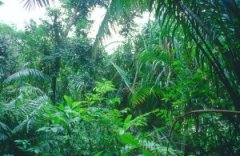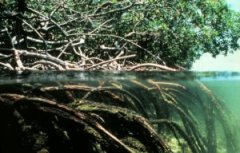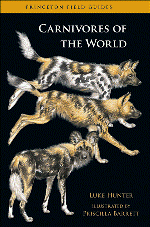Wild Tracks
On behalf of the world's wild species
Tropical Forest Ecosystem
 Rainforests are thought to be the oldest ecosystem on earth (some as old as 100 million years), accounting for the greatest diversity of plants and animals.
Rainforests are thought to be the oldest ecosystem on earth (some as old as 100 million years), accounting for the greatest diversity of plants and animals.
Tropical rainforests exist in three major global areas: Central & South America, Africa and Indo-Malaysia.They are aptly referred to as rainforests, averaging between 125 to 660 cm of rainfall annually.
Tropical rainforests are generally found near the Equator, allowing the most direct sunlight of any habitat; consequently there is no cold season.Temperatures average between 20ºC and 34ºC. The combination of warmth and rainfall creates a very humid environment.The warm air retains the water vapour, but as the air rises and cools, clouds form, producing more rain.
It is calculated that there are more than 50 million different species of invertebrates in the rainforest, by far the largest family found. Many have not yet been identified and even new mammals are still being discovered, such as the tiny maues marmoset monkey, found only in a very small pocket of the Amazon rainforest.
Some plants and animals have developed a close association of mutual benefit (symbiosis). For instance, The Azteca ant finds its nourishment, water and shelter on the acacia tree, and in turn it protects the tree from potential predators by fiercely attacking them.
Seed dispersal by birds and mammals plays a major role in the germination of new trees. The birds and mammals eat the seeds found in fruits, then travel great distances away from the parent tree before defecating and depositing the seeds in a new area.
Scientists have identified over 2,000 tropical forest plants as useful in treating cancer; but these plants are less than 1% of the total biodiversity that have been analyzed so far. That leaves 99% of the plants yet to be studied for possible medicinal properties.
Animal Adaptations
Tropical rainforests are home to a considerable number of fauna species. The diversity of species is highest in the Neotropical forest, second in the Indo-Malaysian area and lowest in Africa, but they share certain adaptive characteristics:
Monkeys are found in all rainforests, and very often more than one species in a particular area. Their great agility allows them to move rapidly from tree to tree. New World monkeys have adapted prehensile tails, allowing them to hang by their tails from tree branches to reach out for fruit and insects on nearby branches. Most monkeys will also spend most of their lives in trees sleeping and eating, in order to protect them from ground-dwelling predators.
Bright colours tend to scare off predators because they have learned that most are actually poisonous. For instance, the poison arrow frog is bright red, yellow or blue and has a sticky toxic coating over its body. Indigenous peoples use this toxin rubbing their arrows on this coating before going out hunting. The brilliant red, yellow and black coral snake is found in the Neotropics. Its bite contains a deadly venom that kills within seconds.
Many animals utilize camouflage to make themselves invisible to potential predators. For instance, the three-toed sloth of the Neotropics hangs upside down from cecropia and other trees, moving so slowly that green algae actually forms on its back, thus making it appear to be part of the tree. Stick insects have evolved to resemble twigs on the branches of trees, blending in so well that they cannot be detected unless they move.
Many animals have adapted to eating only a specific plant or animal, thus avoiding competition from other species. For example, parrots and toucans have very large, strong beaks capable of cracking open the tough shell of fruits and nuts. Leafcutter ants are probably one of the most specialized insects. They climb trees, in a long row to cut off comparatively large pieces of leaves which they then transport back to their burrow below ground. The ants deposit their saliva on the leaves, to form a fungus – their only food source.
Predators such as a jaguar have developed a well-muscled body and powerful jaw in order to catch and crush the skull of its prey. Smaller wild cats such as the margay have unique adaptations to move through the trees as agile as the monkeys they pursue. Scorpions, spiders and some snakes have toxic poisons in order to kill their prey.
Plant Adaptations
Most rainforest trees have straight trunks, with smooth thin bark, making it difficult for plant parasites to hold on to the trees. Trees are indeed important but represent only a small percentage of the organisms that exist in any forest and the complicated relationship that exists between the flora and fauna. For example, insects and bacteria play an essential role in converting dead plant and animal matter into nutrients that are quickly absorbed by the adjacent plants and tree roots. Contrary to what many people believe, the soil is very poor and shallow, and thus the role of these decomposers is extremely important to provide nutrients to sustain plant life.
Rainforests have evolved into four distinct layers of trees:
Emergent Layer – These trees are the tallest (100 to 240 feet) and are spaced wide apart in order to take full advantage of the sunlight.
Upper Canopy – In this layer, the trees grow 60 to 130 feet and receive some sunlight. It is in this layer that most of the rainforest’s animals live because of the abundant food supply found here.
Understory – This layer comprises small trees, shrubs and plants. Because of the constant shade and little air movement, the plants have evolved to adapt to this environment of low light and high humidity.
Forest Floor – Because of the lack of light, few bushes grow there, making it fairly easy for humans to walk through most parts.
It is rare to find more than one tree of the same species close together, and this adaptation ensures that a disease or insect infestation will not eradicate that species. Staggered blooming and fruiting of rainforest trees and plants ensure a year-round supply of food.
 Mangroves forests are a specialized part of tropical rainforests found along the sheltered coastlines and river deltas. The trees here are able to grow in brackish water, sending out roots above the waterline in order to keep the trunk and leaves above the tideline, growing directly into the mud. It is estimated that there are 39.3 million acres of mangroves worldwide. Salt crystals move through the roots into the leaves where they are stored until such time as the leaves are shed.
Mangroves forests are a specialized part of tropical rainforests found along the sheltered coastlines and river deltas. The trees here are able to grow in brackish water, sending out roots above the waterline in order to keep the trunk and leaves above the tideline, growing directly into the mud. It is estimated that there are 39.3 million acres of mangroves worldwide. Salt crystals move through the roots into the leaves where they are stored until such time as the leaves are shed.
These forests support a large biodiversity (range of organisms) providing a breeding ground for fish, shrimp, prawns, crabs, shellfish and snails. They are the nesting site for many shorebirds, and provide shelter and food for monkeys, fishing cats, lizards, sea turtles and fruit bats, to name but a few.
Mangrove forests are considered one of the most threatened habitats in the world because of pollutants such as crude oil, sewage and toxic wastes; artificial dikes and sea walls cause flooding; the wood is being cut down to provide a high grade of charcoal. Mangroves are also being filled in as a form of mosquito control and to provide land for development projects.
Effects of Global Warming on Tropical Forests
- Although scientists state that the tropical rainforests are responsible for producing 40% of the Earth’s oxygen, we are losing a piece of rainforest the size of a football field every second!! That equates to 31 million football fields of rainforest disappearing forever every year!
- The destruction of the world’s rainforests is creating mass extinction of animals and plants that exist only in this unique habitat, and also is destroying the homes of many indigenous peoples.
- According to The Nature Conservancy “rainforests act as the world’s thermostat by regulating temperatures and weather patterns; one-fifth of the world’s fresh water is found in the Amazon Basin, and rainforests are critical in maintaining the Earth’s limited supply of drinking and fresh water”.
- One of the major causes of global warming is the destruction of rainforests, which coincidentally exist in some of the poorest nations on Earth. We know this and yet the slaughter continues unabated.

THANK YOU WHOEVER
thank you. this really helped me with my project. thank you
thank you thank you thank you thank you. SVP SVP SVP SVP
helps a lot
this really helped me
Im satisfied with what I read. Helped a lot with my project.
This really helps with my art project